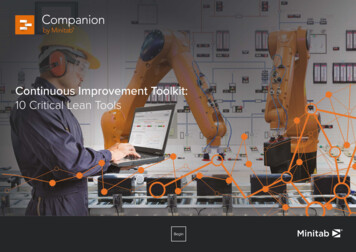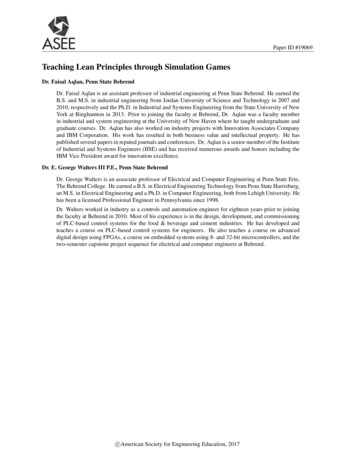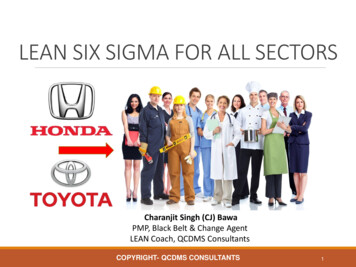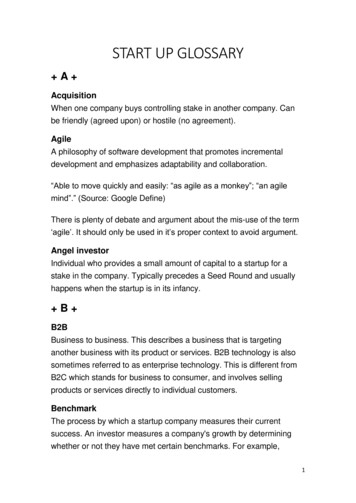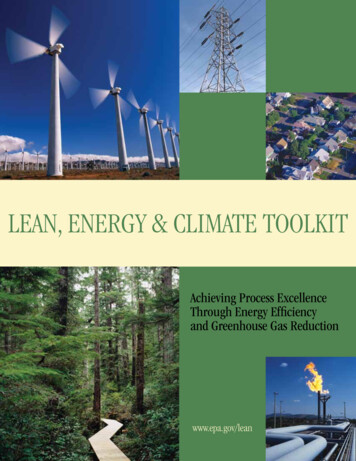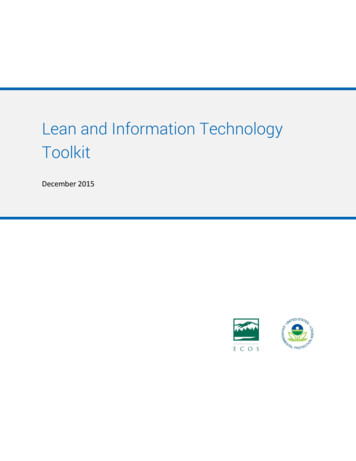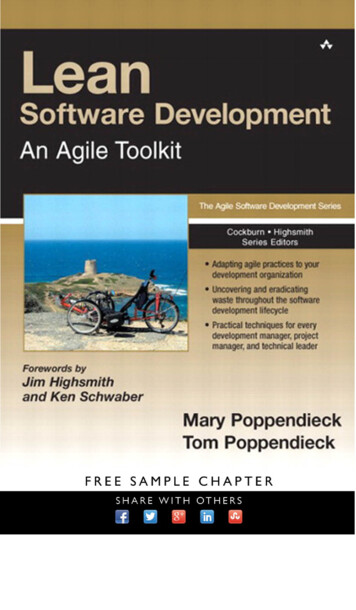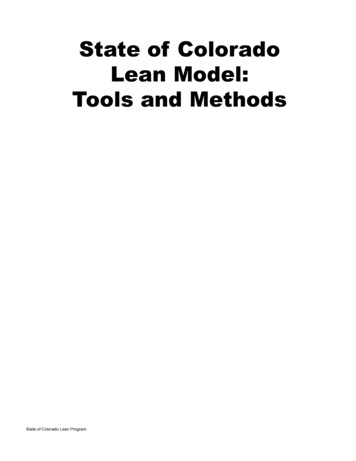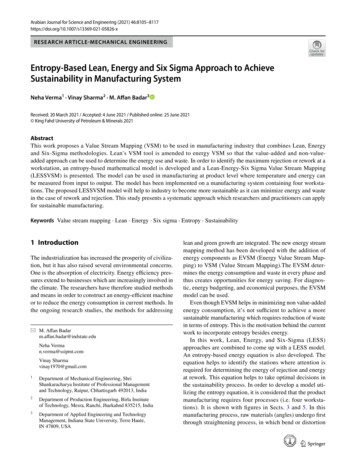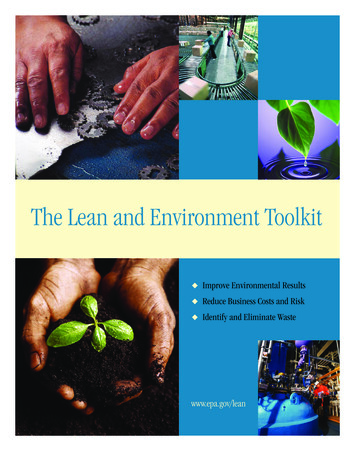
Transcription
The Lean and Environment Toolkit Improve Environmental Results Reduce Business Costs and Risk Identify and Eliminate Wastewww.epa.gov/lean
Toolkit Format and IconsThe toolkit uses icons in the page margins to help you find andfollow important information in each chapter.Key Point Identifies an important point to rememberKey Term Defines an important term or conceptNew Tool Presents a technique or resource that helpscapture, communicate, or apply new knowledgeHow-to Steps Describes sequenced actions toimplement a toolChapters also include one or more “To Consider” text boxes thatcontain questions to help you explore how the information relatesto your organization.
Lean and Environment ToolkitTable of ContentsPreface . iAcknowledgments .iiiChapter 1Introduction: Getting Started with Lean & Environment . 1Chapter 2Identifying Environmental Wastes . 11Chapter 3Value Stream Mapping . 21Chapter 4Kaizen Events . 35Chapter 56S (5S Safety) . 49Chapter 6Conclusion and Implementation Strategies. 61AppendicesAppendix A Lean Methods . 67Appendix B Basic Environmental Measures for Lean Enterprises . 74Appendix C Lean Event EHS Checklist . 77Appendix D Pollution Prevention Resources . 79Appendix E 6S Safety Audit Checklist. 81
Lean and Environment ToolkitPrefaceThis Lean and Environment Toolkit assembles practical experience collected by the U.S. Environ mental Protection Agency (EPA) from a group of partner companies and organizations that haveexperience with coordinating Lean implementation and environmental management. The toolkitbuilds on work conducted and research sponsored by EPA’s Lean Manufacturing and EnvironmentInitiative (see http://www.epa.gov/lean).The EPA’s intent in developing this toolkit is to enable Lean practitioners to improve both their busi ness performance and their environmental performance by identifying and eliminating environ mental wastes at their organizations. The toolkit offers practical strategies and tools for integratingenvironmental considerations into Lean initiatives in ways that support Lean’s focus on the elimina tion of waste and non-value added activity.This is the second iteration of the Toolkit. EPA welcomes your comments and reflections on thisdocument, as well as other ideas you have for Lean and environment strategies, tools, and resourceswhich can be incorporated in future versions of the toolkit. Please contact EPA to share your experi ences with Lean and the environment and/or to discuss partnership opportunities by using the formfound at http://www.epa.gov/lean/auxfiles/contact.htm.i
Lean and Environment ToolkitAcknowledgmentsThe U.S. Environmental Protection Agency is very grateful for the invaluable assistance of its part ners in developing this toolkit. EPA’s partners shared their experiences, tools, and techniques forintegrating Lean and environmental management, and worked collaboratively with EPA to develop,test, and refine the content of this toolkit.EPA’s Lean and Environment partners include: Baxter International, Chicago Manufacturing Center,CONNSTEP, HNI Corporation, Robins Air Force Base, Rockwell Collins, and the U.S. Army MaterielCommand. Participating Offices at EPA include: the National Center for Environmental Innovation;the Office of Pollution Prevention and Toxics; and the Office of Solid Waste.In addition to these organizational partners, this toolkit has benefited from the collective expertiseand ideas of many individuals. In particular, EPA would like to thank the following individuals fortheir thoughtful contributions:Pat Bartholomew of Baxter InternationalKate V. Bates of Earth Tech, Inc., working with Robins Air Force BaseDave Bury of Robins Air Force BaseJenni Cawein of Baxter InternationalAngie Coyle of Delphi CorporationRob Currie of Baxter InternationalJames Ellor of Elzly Technology Corporation, working with the U.S.Army Materiel CommandMike Fisher of Baxter InternationalVicki Fisher of Rockwell CollinsAntonia Giardina of the U.S. Army Materiel CommandScott Lesnet of HNI CorporationAlistair Stewart of the Chicago Manufacturing CenterKaren Wan of the Chicago Manufacturing CenterMegan Wertz of The George Washington UniversityJudy Wlodarczyk of CONNSTEP, Inc.This toolkit was prepared for the U.S. Environmental Protection Agency by Ross & AssociatesEnvironmental Consulting, Ltd. in association with Industrial Economics, Inc.(EPA Contract # EP-W-04-23).iii
CHAPTER 1Introduction: Getting Started with Lean & EnvironmentChapter ContentsPurpose of This ToolkitKey Questions Addressed by the ToolkitWhy Use This Toolkit1. Learn to See Hidden Environmental Waste2. Enhance the Effectiveness of Lean Implementation3. Deliver What Customers and Employees WantHow to Use This ToolkitToolkit Structure and Chapters Toolkit Format and IconsConclusionSummaryYour Thoughts1
Chapter 1: Introduction—Getting Started With Lean & EnvironmentPurpose of This ToolkitThe Lean and Environment Toolkit offers practical strategies and techniques to Lean imple menters about how to improve Lean results—waste elimination, quality enhancement, anddelivery of value to customers—while achieving environmental performance goals. The toolkitalso provides tools to help your organization get better environmental performance from Lean ef forts on the shop floor.Benefits of Coordinating Lean & Environment Reduce costsImprove process flow and reduce lead timesLower regulatory non-compliance riskMeet customer expectationsImprove environmental qualityImprove employee morale and commitmentThe “Lean” methods discussed in this Toolkit are organizational improvement methods pioneered inthe Toyota Production System. Lean production and Lean manufacturing refer to a customer-fo cused business model and collection of methods that focuses on the elimination of waste (non-valueadded activity) while delivering quality products on time and at a low cost. The toolkit assumes thatyou are familiar with Lean methods and their implementation. For those who want to learn moreabout Lean methods discussed in the toolkit, see Appendix A.Key Questions Addressed by the ToolkitLean works well when it focuses on identifying and eliminating non-value added activity. Environ mental improvement efforts that have potential to distract Lean efforts from this prime focus willlikely not get much traction. By contrast, this toolkit contains strategies and techniques that canseamlessly enable Lean practitioners to easily identify environmental wastes and improvement op portunities alongside the myriad other wastes and improvement opportunities uncovered by Lean.To accomplish this, the toolkit aims to answer the following questions:What is environmental waste?Environmental waste is an unnecessary or excess use of resources or a substance released to theair, water, or land that could harm human health or the environment. Environmental wastes canoccur when companies use resources to provide products or services to customers, and/or whencustomers use and dispose of products. Chapter 2 defines and provides examples of environmen tal waste.2
Chapter 1: Introduction—Getting Started With Lean & EnvironmentWhy should I identify environmental waste in my processes?Environmental wastes do not add value to the customer. Environmental wastes can also directly af fect production flow, time, quality, and cost—making them ripe targets for Lean initiatives. In manycases, the costs associated with pollution and wasted energy, water, and raw materials can be signifi cant. This chapter (Chapter 1) discusses the business case for eliminating environmental waste.How will I know when I see environmental waste?Some environmental wastes are easy to see. Containers of solid and hazardous waste are visualindications of environmental waste. Health and environmental risks posed by certain chemicals ormaterials can be more difficult to see, although they can represent costly non-value added aspects ofa process or product. Chapter 2 provides examples of environmental wastes and describes organi zational strategies that will make it easier to know when you see them.Where should I look for environmental wastes?Environmental wastes can be found in almost any process. Processes requiring environmental permits—such as painting, metal finishing, and hazardous waste management processes—are oftena good place to look for environmental improvement opportunities. If your organization has anenvironmental management system (EMS), your Environmental, Health and Safety (EHS) personnelmay have already identified key environmental impacts associated with each of the organization’sprocesses. Chapter 3 discusses how value stream mapping (VSM) tools and techniques can beused to help Lean practitioners see environmental wastes in processes. Chapter 4 discusses how toidentify and address environmental wastes during kaizen rapid improvement events.How do I measure the environmental impacts of a process?Measurement of key environmental wastes associated with a process can pinpoint those wastes thatare most important to track over time. For example, chemical use and hazardous waste generationmay be important to measure for one process, while water use may be most important to measurefor another process. Chapter 3 discusses techniques for integrating environmental metrics intovalue stream maps. Appendix B includes information on environmental metrics that are oftenused by companies and facilities.Where can I find environmentally preferable alternatives to my current process?EHS professionals in your organization may have ideas and information regarding environmentallypreferable processes, equipment and materials. In addition, numerous organizations, including EPA,have developed technical assistance resources and programs to assist organizations in improvingthe environmental and operational performance of processes. Chapter 4 discusses several usefulresources and technical assistance networks. There are also Pollution Prevention Resources inAppendix D.3
Chapter 1: Introduction—Getting Started With Lean & EnvironmentWhy Use This ToolkitExplicit consideration of environmental goals and opportunities during Lean implementa tion can create significant value for an organization—helping to deliver quality products andservices that customers want, when they want them. Research sponsored by EPA and others showsthat environmental performance benefits typically ride the coattails of Lean efforts, yet these effortsmay overlook other opportunities to reduce wastes and non-value added activity. Adding environ mental considerations to Lean efforts can increase value, accelerate Lean implementation, decreasematerial costs, and reduce liability and the risk of compliance violations.Business Case for Integrating Lean & Environment1. Learn to see hidden environmental waste.2. Enhance the effectiveness of Lean implementation.3. Deliver what customers and employees want.Below are three key reasons why business leaders, Lean practitioners and EHS managers have pur sued efforts to coordinate Lean and environmental management activities.1. Learn to See Hidden Environmental Waste and HazardsLearning to see and eliminate waste is a cornerstone of Lean initiatives. There is one type of waste,however, that often goes unaddressed (or under addressed) by Lean initiatives—environmentalwaste. When grouped together, environmental wastes can result in huge costs to business. Thesecosts include raw material and disposal costs, as well as costs for compliance management activitiesand pollution control equipment.Lean’s focus on eliminating non-value added activity is excellent at driving down the volume of ma terial, water, energy, chemical usage, and wastes, producing important competitiveness and environ mental benefits. The environmental risk and full lifecycle impacts that materials and chemicals poseto human health and the environment, however, are rarely considered during Lean implementation.Learning to see environmental wastes during Lean efforts can open significant business improve ment opportunities, further strengthen Lean results, and improve environmental performance.Environmental wastes are often a sign of inefficient production, and they frequently indicateopportunities for saving cost and time. The chemicals and hazardous materials used in a processoften demand costly support activities, such as regulatory compliance management and reportingactivities, use of personal protective equipment, and the investment, operation, and maintenance ofpollution control equipment. These activities do not add value to the customer, and they can createunnecessary risks to worker health and safety.Chemical substitution, process changes, and other strategies can reduce the need for such non-valueadded activities. For these reasons, learning to see and eliminate environmental wastes can greatlyimprove the time, quality, and cost results of Lean initiatives.4
Chapter 1: Introduction—Getting Started With Lean & Environment2. Enhance the Effectiveness of Lean ImplementationExplicit coordination of Lean and environmental initiatives can lead to compelling organizationaland environmental improvement results. For example, Lean thinking can be applied to variousenvironmental management processes, such as chemical and waste management. Companies havefound that as much as 40 percent of their chemical supplies were going unused and directly be coming hazardous waste as they expired on the shelf or became obsolete. Using Lean principles toimprove chemical and waste management processes can have big pay-offs for environmental perfor mance and bottom-line results.Case Study: Lockheed Martin CorporationLockheed Martin Corporation, the world’s largest defense contractor, hasbeen implementing Lean techniques corporate-wide since the late 1990s.Lockheed Martin’s Manassas plant conducted improvement events to ap ply Lean thinking to its chemical and waste management activities becausea significant amount of warehoused chemicals were going directly to thehazardous waste stream without ever being used, expired on-shelf, or wereno longer used for research or production. Lockheed Martin sought to movetoward a just-in-time chemical management system, with chemicals deliveredthree times a week in “right-sized” containers to meet real-time demand.The Lean events reduced chemical inventories, freed capital tied up in inven tory, increased chemical inventory turns and chemical utilization rates, andeliminated the chemical warehouse and chemicals expiring on the shelf.Proactive Lean and environment coordination can also anticipate and ease environmentalconstraints to leaning “monument” processes, thereby enabling large performance gains. Mon uments are production processes or process steps that have large equipment and/or other physicalor environmental regulatory constraints that make them very difficult or costly to move, which cancomplicate Lean efforts. Typical monuments include painting and metal finishing processes.Making changes to monument processes can require approval or permits from environmental regu latory agencies, as well as special work practices or control measures, all of which can be difficult toaccomplish within rapid timeframes. EHS personnel can help to identify environmentally friendlyprocess alternatives, and ensure that process changes can be made as quickly as possible.5
Chapter 1: Introduction—Getting Started With Lean & EnvironmentCase Study: Apollo HardwoodsApollo Hardwoods used Lean methods to manufacture custom “cut-to-size”cherry plywood for cabinetry. The company’s founders and investors discov ered that a “right-sized” veneering process would require less expensiveequipment, use a wider variety of logs, and produce less wood scrap, with out compromising product quality. The company sought to find a veneeringprocess that would also address product quality, flow time, and cost. Sincesuch a process did not exist, Apollo Hardwoods recruited a team to developa Lean veneer slicing and drying process and associated equipment usingthe pre-production planning (3P) method. The Lean veneer manufacturingprocess incorporated one-piece flow cells that eliminated the piling of inven tory in between steps. The “right-sized” equipment requires less capital thanconventional machinery (or “monuments”), uses less energy, fits into smallproduction cells, and allows Apollo Hardwoods to fabricate the same amountof finished product using fewer logs and generating less wood scrap.3. Deliver What Customers and Employees WantMost customers who purchase products do not want to buy environmental wastes, impacts, or risk.Companies that can deliver products and services with fewer environmental impacts have thepotential to capture significant competitive advantage, provided that there are not sacrifices intime, quality, or cost. In many markets products with superior environmental performance canattract new customers.Explicit consideration of environmental waste in Lean initiatives can also improve the work envi ronment for employees. Similar to ergonomic concerns, eliminating environmental hazards canreduce potential worker exposure to toxic substances and create a cleaner and safer workplace.In addition, employees want to do the right thing. When employees take pride in their work becausethey believe it has broader benefits to their community and the world, there can be a substantial posi tive effect on organizational morale. This can empower employees and further enhance productivity.To Consider How could your company benefit from improved Lean and environmental per formance? (Think about time and cost savings, reduced risks and liabilities,added value to customers, etc.) How well coordinated are Lean and environmental management activities inyour organization? Do EHS personnel participate in Lean events and initiatives at your company?6
Chapter 1: Introduction—Getting Started With Lean & EnvironmentHow to Use This ToolkitThis section describes the structure and organization of the Lean and Environment Toolkit (Ver sion 1.0), as well as icons that are used to help you navigate the information easily. The toolkit isdesigned so that you can work through the full content in an ordered manner or skip to specificmethods that are of most interest.Toolkit Structure and ChaptersThe toolkit is structured in chapters, each focusing on strategies, tools, and techniques to enhancethe success of Lean initiatives while improving environmental performance. Chapters 2–5 focus oncore Lean methods and how-to strategies for leveraging environmental considerations to enhanceLean results. The diagram below illustrates how these chapters focus on coordinating Lean and en vironmental activities on different organizational levels—the value stream level, the process level,and the work area level. Chapter 6 provides summary points and guidance to assist you in puttingthe strategies and techniques discussed in the toolkit to work in your organization.Figure 1: Diagram of Toolkit ComponentsImproved Lean & yingEnvironmentalWastes(Chapter 2)Value StreamLevelValue StreamMapping(Chapter 3)ProcessLevelKaizen EventsWork AreaLevel6S (5S Safety)(Chapter 5)7
Chapter 1: Introduction—Getting Started With Lean & EnvironmentConclusionSummaryThis toolkit provides practical strategies, tools, and techniques for incorpo rating environmental considerations into already existing Lean initiatives inan effort to improve Lean results and add value to your organization.There are three key reasons why business leaders, Lean practitioners, andEHS managers pursue efforts to coordinate Lean and environmental man agement activities.1. Learning to see and eliminate hidden environmental wastes during Leanimplementation can lead to more efficient production by improving thetime, quality, and cost results of Lean initiatives. Chemical substitution,process changes and other strategies can reduce the need for non-valueadded activities—such as regulatory compliance management and invest ment in pollution control equipment—that might otherwise be overlookedby Lean alone.2. Coordination of Lean and environmental management can facilitate moreprocess improvement and make it easier to apply Lean to processes withenvironmental regulatory constraints. EHS personnel can assist Leanimplementation by anticipating and addressing environmental constraintssuch as the need to obtain permits, and by identifying environmentallyfriendly process alternatives.3. A significant competitive advantage can be attained by providing customerswith products and services with less environmental impacts, and by improv ing the work environment for employees.8
Chapter 1: Introduction—Getting Started With Lean & EnvironmentYour ThoughtsNow that you have finished this chapter, reflect on what you read byanswering these questions: What did you learn in this chapter that was particularly useful? Do you need any more information to fully understand the businesscase for identifying and eliminating environmental waste? How strongis the business case for doing this in your organization? What ideas do you have for helping your organization learn to seeenvironmental wastes?Notes:9
CHAPTER 2Identifying Environmental WastesChapter ContentsIntroduction to Value Stream MappingDefinition of Environmental WasteThe Link Between Environmental Waste and Lean’s Seven DeadlyWastesHow to “Learn to See” Environmental Waste in Your OrganizationOverview of Organizational Strategies1. Add Environmental Metrics to Lean Metrics2. Show Management Commitment and Support3. Include Environmental Waste in Lean Training Efforts4. Make Environmental Wastes Visible and Simple to Eliminate5. Recognize and Reward SuccessConclusionSummaryYour Thoughts11
Chapter 2: Identifying Environmental WastesIntroduction to Identifying Environmental WastesThis chapter defines environmental waste and describes strategies to encourage employees to iden tify and eliminate environmental waste as part of Lean efforts.Definition of Environmental WasteEnvironmental waste is any unnecessary use of resources or a substance released into the air,water, or land that could harm human health or the environment. Environmental wastes can occurwhen companies use resources to provide products or services to customers, and/or when customersuse and dispose of products. Practically speaking, environmental wastes include: Energy, water, or raw materials consumed in excess of what is needed to meet customerneeds. Pollutants and material wastes released into the environment, such as air emissions,wastewater discharges, hazardous wastes and solid wastes (trash or discarded scrap). Hazardous substances that adversely affect human health or the environment during theiruse in production or their presence in products.Like other Lean wastes, environmental wastes do not add customer value. They also represent coststo the enterprise and society in general.The Link Between Environmental Waste and Lean’s Seven DeadlyWastesThe focus of Lean is on eliminating any non-value added activity, or waste, from production. Leantypically targets seven so-called deadly wastes:1. Overproduction5. Defects2. Inventory6. Over Processing3. Transportation7. Waiting4. Motion12
Chapter 2: Identifying Environmental WastesCase Study: RejuvenationRejuvenation, a manufacturer of period-authentic reproduction lighting andhardware, operates on the philosophy that the reuse and improvement of oldproperties has environmental benefits. Using an environmental managementsystem based on The Natural Step and Lean manufacturing, Rejuvenationhas reduced its environmental wastes and increased quality and profit. Priorto Lean implementation, finished products were not inspected until the endof the line at a quality control center, causing expensive rework if mistakeswere found. Through Lean events, the quality control center was eliminated,quality control became everyone’s job, and customization errors are nowcorrected before moving on to the next process. Rejuvenation also regularlyimplements other Lean tools such as 5S, kaizen events, and value streammapping.Environmental wastes, such as hazardous materials released to the environment, are not explic itly included in the seven deadly wastes of the Toyota Production System. However, this does notmean that the deadly wastes are unrelated to the environment. In fact, your company may have al ready seen large environmental gains from implementing Lean, because environmental wastesare embedded in, or related to, the seven deadly wastes.The table below lists environmental impacts that are associated with the deadly wastes targeted byLean methods. By reducing these production wastes through Lean efforts, you can improve yourorganization’s environmental performance.Table 1: Environmental Impacts of Deadly WastesWaste TypeOverproductionEnvironmental Impacts More raw materials and energy consumed inmaking the unnecessary products Extra products may spoil or become obsoleterequiring disposal Extra hazardous materials used result in extraemissions, waste disposal, worker exposure, etc.Inventory More packaging to store work-in-process (WIP) Waste from deterioration or damage to stored WIP More materials needed to replace damaged WIP More energy used to heat, cool, and light inventoryspace13
Chapter 2: Identifying Environmental WastesTable 1: Environmental Impacts of Deadly Wastes (continued)Waste TypeTransportation andMotionEnvironmental Impacts More energy use for transport Emissions from transport More space required for WIP movement, increasinglighting, heating, and cooling demand and energyconsumption More packaging required to protect componentsduring movement Damage and spills during transport Transportation of hazardous materials requiresspecial shipping and packaging to prevent riskduring accidentsDefects Raw materials and energy consumed in makingdefective products Defective components require recycling or disposal More space required for rework and repair, increas ing energy use for heating, cooling, and lightingOver processing More parts and raw materials consumed per unitof production Unnecessary processing increases wastes, energyuse, and emissionsWaiting Potential material spoilage or component damagecausing waste Wasted energy from heating, cooling, and lightingduring production downtimeDespite these relationships between Lean “deadly wastes” and environmental wastes, Lean imple mentation efforts often overlook opportunities to prevent or reduce environmental wastes. Yourcompany can enhance its Lean performance by ensuring that environmental wastes are ex plicitly identified during Lean events and activities. This can be done by extending Lean wasteidentification activities to consider wasted materials, pollution and other non-product outputs.This toolkit provides you with some tools to identify and eliminate environmental waste—includingsome that are well hidden—and to maximize the environmental gains from Lean implementation.14
Chapter 2: Identifying Environmental WastesTo Consider What types of environmental performance gains has your companyseen from implementing Lean methods? (For example, have you re duced chemical use in a process, generated smaller quantities ofhazardous waste, or reduced vehicle travel thereby reducing exhaustemissions and fuel use?) If you don’t know, how will you find out? Name three examples of environmental wastes you could reduce atyour company. What steps could you take to eliminate those wastes?How to “Learn to See” Environmental Waste inYour OrganizationOverview of Organizational StrategiesAs Lean leaders know, people are the key to successful Lean implementation. In much the same way,organizational culture is an important aspect of effective integration of environmental, health, andsafety objectives into Lean improvement efforts. While each organization has different needs, severalorganizational strategies will help to accomplish your company’s Lean and environment efforts.1. Add environmental metrics to Lean metrics.2. Show management commitment and support.3. Include environmental waste in Lean training efforts.4. Make environmental wastes visible and simple to eliminate.5. Recognize and reward success.1. Add Environmental Metrics to Lean MetricsOne simple way to understand how your company’s Lean efforts are affecting the environment isto add one or more environmental performance metrics to the metrics used to evaluate and trackthe success of Lean implementation. See the textbox below for examples of types of environmentalmetrics and Appendix B for a detailed list of environmental performance metrics.15
Chapter 2: Identifying Environmental WastesTypes of Environmental
environmental considerations into Lean initiatives in ways that support Lean’s focus on the elimina tion of waste and non-value added activity. This is the second iteration of the Toolkit. EPA welcomes your comments and reflections on this document, as well as other ideas you have for Lean and envi
